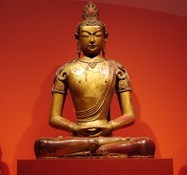Foundation of Buddhist Thought Course
 The Foundation of Buddhist Thought is a two-year course in Buddhist studies created by Geshe Tashi Tsering of Jamyang Buddhist Centre in London. The program draws upon the depth of Tibetan Buddhist philosophy to exemplify how Buddhism can make a real difference in the way we live our lives. The Foundation of Buddhist Thought is part of the Foundation for the Preservation of the Mahayana Tradition (FPMT) core study program. This course can be taken either in person or online. It consists of the following six four-month modules:
The Foundation of Buddhist Thought is a two-year course in Buddhist studies created by Geshe Tashi Tsering of Jamyang Buddhist Centre in London. The program draws upon the depth of Tibetan Buddhist philosophy to exemplify how Buddhism can make a real difference in the way we live our lives. The Foundation of Buddhist Thought is part of the Foundation for the Preservation of the Mahayana Tradition (FPMT) core study program. This course can be taken either in person or online. It consists of the following six four-month modules:
-
The Four Noble Truths
-
Relative Truth, Ultimate Truth
-
Buddhist Psychology
-
The Awakening Mind
-
Emptiness
-
Tantra
A mixture of reading, listening, meditating, discussing, and writing ensures that each student will gain an understanding and mastery of these profound and important concepts. A vital aspect of the course is Geshe Tashi’s emphasis on the way these topics affect our everyday lives.
To find out more about The Foundation of Buddhist Thought, please visit
the following website: www.buddhistthought.org. To find out more about the FPMT study programs, please visit: www.fpmt.org.
Class Descriptions
These are some of the subjects covered in each module.
The Four Noble Truths
Looking at each of The Four Noble Truths – suffering, the origin of suffering, the cessation of suffering, and the path that leads to the cessation of suffering – and how they form an overview of the entire Buddhist path. Topics include:
-
Suffering: being our own refuge, avoiding the two extremes, taking universal responsibility
-
Origin: the three types of suffering, the five aggregates, letting go of clinging
-
Cessation: the two types of ignorance, cause and effect, the heaviness of a karmic action, dealing with afflictive emotions, the twelve links of dependent origination, cessation
-
Cessation: liberation and enlightenment, the dharmakaya and the rupakaya
-
Path: the three trainings (ethics, concentration and wisdom), The Noble Eightfold Path, The Five Paths
Relative Truth, Ultimate Truth
Looking at relative and ultimate truth and how an understanding of each is vital to progress on the path. Using the progressively subtler views of the four main Buddhist philosophical schools, we look at how our perception of reality is obscured or clarified depending on what we hold to be true.
Topics include:
-
Moving beyond conventional ways of thinking
-
Buddhist tenets, the four seals
-
The way the Vaibhasika school sees each truth
-
The four types of generality according to the Sautrantika school
-
Conceptual consciousnesses and direct perception
-
The Cittamatra (Mind Only) school and how it views the existence of objects
-
The definitions of The Two Truths according to the Middle Way schools
-
The relationship between the Middle Way schools
Buddhist Psychology
Looking at the mind as it is taught in Tibetan Buddhism, particularly the mind and mental factors. Topics include:
-
What is mind?
-
Abhidharma and pramana
-
The differences and similarities between a main mind and its mental factors
-
Divisions of the mental factors according to how they affect our life
-
Three zones of increasing subtlety of unwholesome mental factors
-
Epistemology – the process of the mind, how our mind engages an object
-
The seven-fold division (wrong consciousnesses to direct perceivers)
The Awakening Mind
Looking at the importance of compassion in our lives and the traditional techniques for developing bodhicitta, the mind of enlightenment. Topics include:
-
Love, compassion and bodhicitta
-
The different approaches to the wisdom and method sides of our practice
-
The seven points of the cause and effect method
-
Exchanging oneself for others method (tonglen)
-
The ten deeds of the bodhisattva
Emptiness
Looking at the most profound view of emptiness – the view that brings release from samsara – as expounded by the Middle Way Prasangika school. Topics include:
-
Ultimate truth and bodhicitta
-
The Heart Sutra
-
The concept of selfhood (object of negation)
-
The four objections and the seven-point analysis
-
Memory and self-consciousness according to Prasangika
-
The three levels of dependent arising
An Overview of Tantric Paths and Grounds
Looking in depth at what tantra is and what it means to do a vajrayana practice, based on a detailed study of the Guhyasamaja practice. The module is extraordinary in the way this profound and very esoteric subject is made accessible. Topics include:
-
Unique features of vajrayana
-
Four complete purities
-
Deity yoga
-
The four classes of tantra
-
Initiations, the lower tantras
-
Concentration on the four branches of recitation
-
The generation and completion stages within Highest Yoga Tantra
Source: http://www.buddhistthought.org/?page_id=53 (Accessed May 31, 2014)
Photo Credit: Intellimon Ltd.
